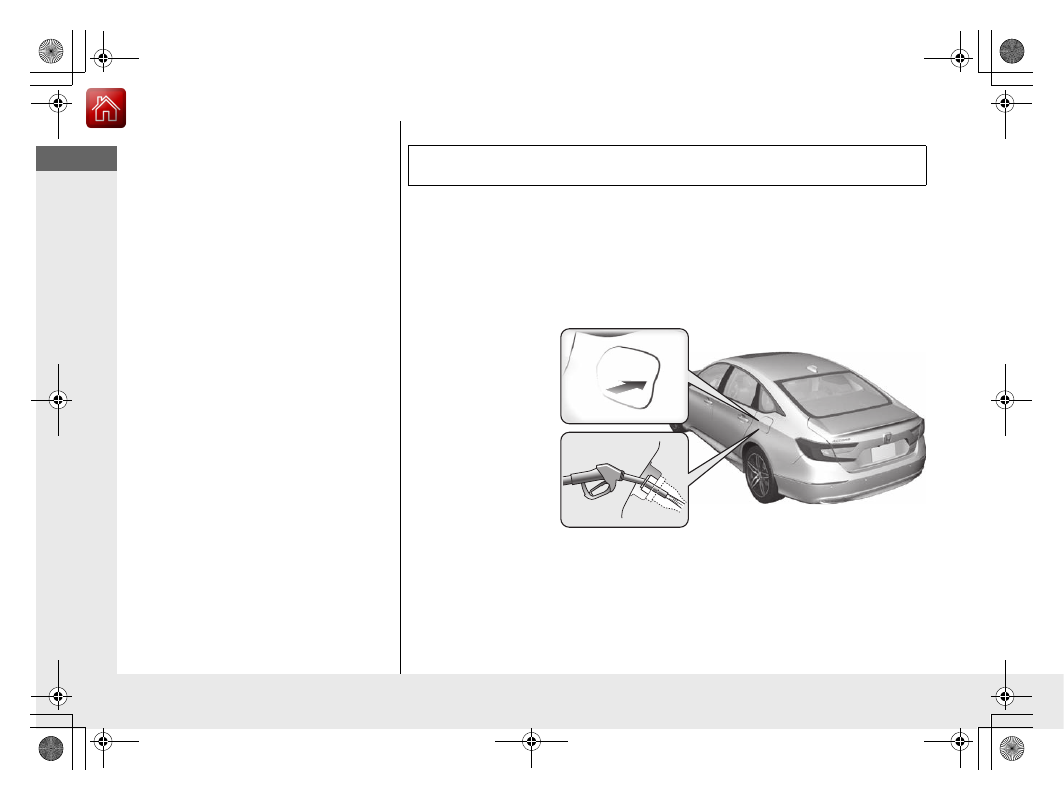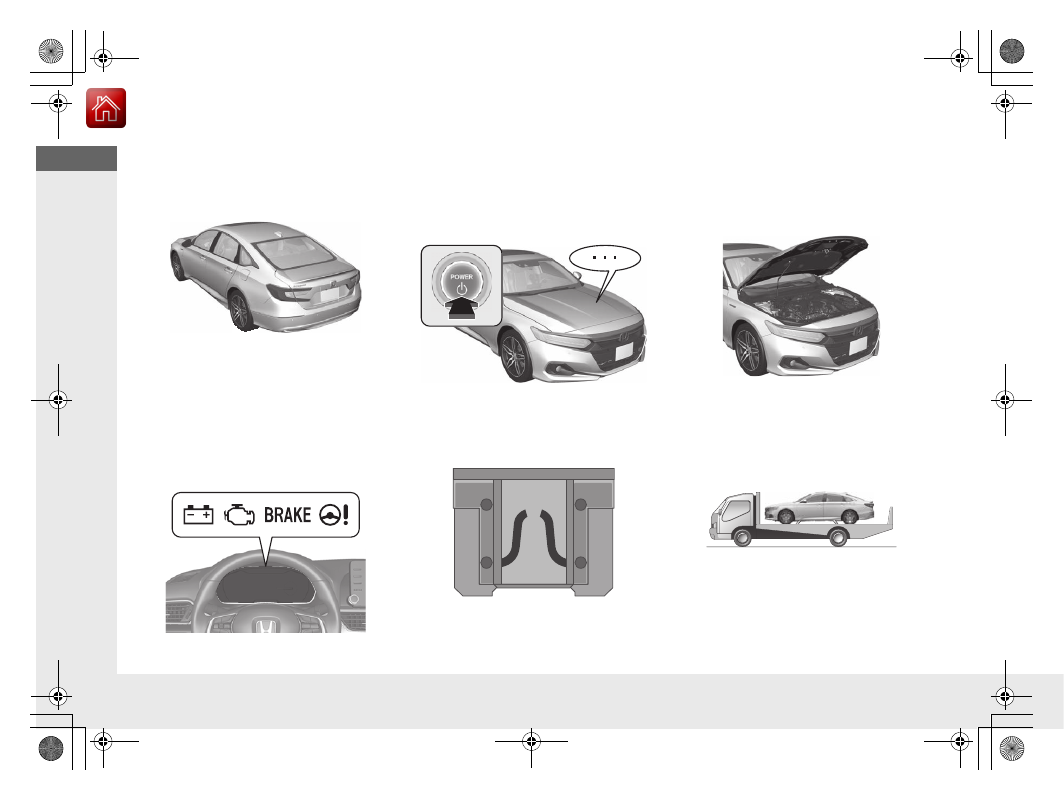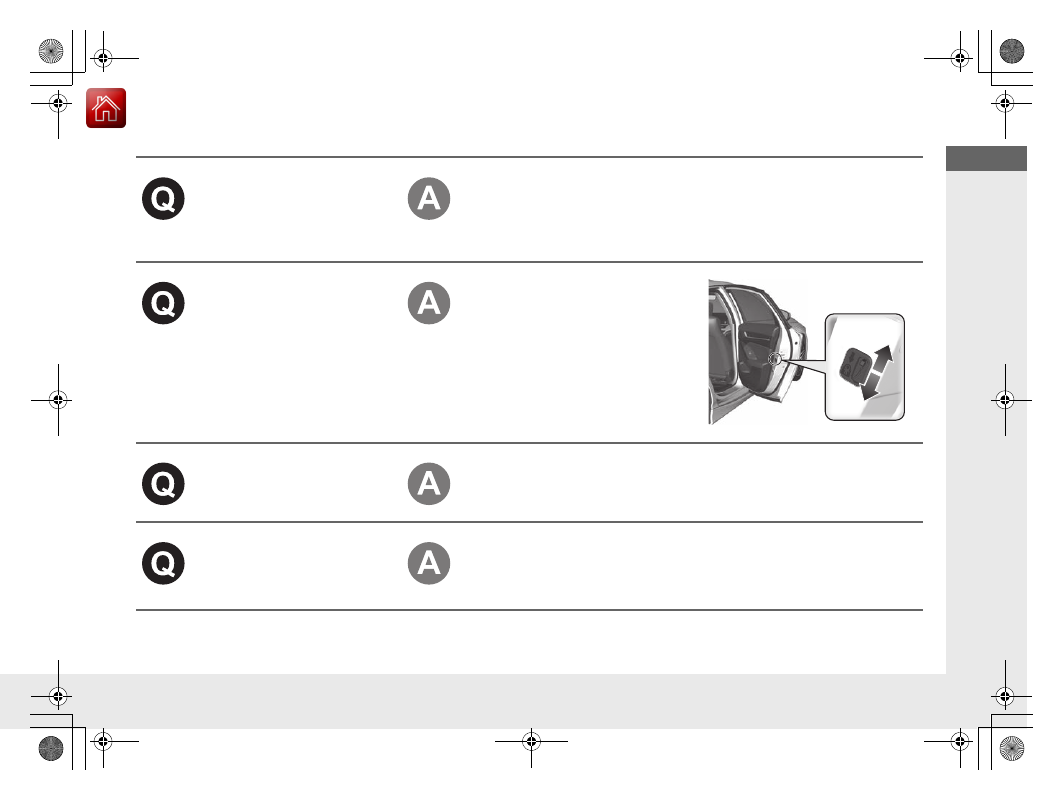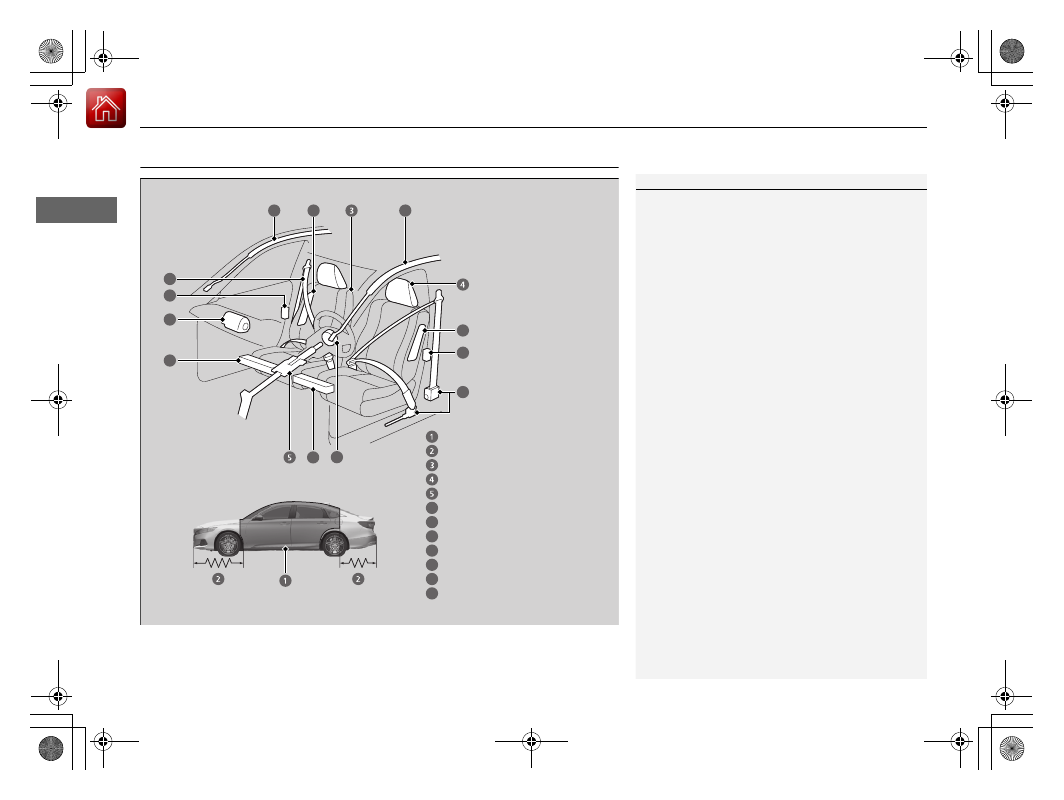Honda Accord Hybrid (2022 year). Manual in english — page 2

28
Quick
Referenc
e Guide
Driving
Transmission
●
Select
(
P
and depress the brake pedal when turning on the power.
●
Shift selection
Park
Press the
(
P
button.
Used when parking or before turning the power on or off.
Transmission is locked.
Reverse
Press back the
(
R
button.
Used when reversing.
Neutral
Press the
(
N
button.
Transmission is not locked.
Drive
Press the
(
D
button.
Used for normal driving.
The deceleration paddle selector can be used temporarily.
The deceleration paddle selector can be used when SPORT mode is on.
Shift Position Indicator
The shift position indicator
and the shift button indicator
indicate the current shift
selection.
Shift Position Indicator
Shift Button
Indicator
READY Indicator
On: You can start to drive.

29
Quick
Referenc
e Guide
Deceleration Paddle Selector
When you release the accelerator pedal, you can control the rate of
deceleration without releasing your hands from the steering wheel. Using
the deceleration paddle selector situated on the steering wheel, you can
sequentially shift through four stages of deceleration.
Pull the
(
+
selector for a few seconds when you want to cancel the
deceleration paddle selector.
●
When SPORT mode is OFF
If you pull back the paddle selector, the rate of deceleration will change
temporarily, and the stage will appear in the instrument panel.
●
When SPORT mode is ON
If you pull back the paddle selector, the rate of deceleration will change
and the stage along with
M
will appear in the instrument panel.
(
-
Paddle
Selector
(
+
Paddle
Selector
Deceleration
stage
When SPORT
mode is OFF,
the
deceleration
stage appears.
When SPORT
mode is ON, the
deceleration
stage and
M
appear.

30
Quick
Referenc
e Guide
VSA
®
On and Off
●
The Vehicle Stability Assist
TM
(VSA
®
)
system helps stabilize the vehicle during
cornering and helps maintain traction
while accelerating on loose or slippery
road surfaces.
●
VSA
®
comes on automatically every time
you turn on the power system.
●
To partially disable or fully restore VSA
®
function, press and hold the button until
you hear a beep.
CMBS
TM
On and Off
●
When a possible frontal collision is likely
unavoidable, the CMBS
TM
can help you to
reduce the vehicle speed and the severity
of the collision.
●
The CMBS
TM
is turned on every time you
turn on the power system.
●
To turn the CMBS
TM
on or off, use the
safety support switch.
Tire Pressure Monitoring
System (TPMS)
●
Detects a change in tire conditions and
overall dimensions due to decrease in tire
pressures.
●
The TPMS is turned on automatically
every time you turn on the power system.
●
A calibration procedure must be
performed when certain conditions arise.
Refueling
Fuel recommendation:
Unleaded gasoline, pump octane number 87 or higher
Fuel tank capacity: 12.81 US gal (48.5 L)
a
Unlock the driver’s
door using the
master door lock
switch.
2
Using the Master
Door Lock Switch
b
Press on the edge of
the fuel fill door to
make it pop up
slightly.
c
After refueling, wait
for about five
seconds before
removing the filler
nozzle.

31
Quick
Referenc
e Guide
Honda Sensing
®
(P 447)
Honda Sensing
®
is a driver support system
which employs the use of two distinctly
different kinds of sensors, a radar sensor
located at the lower part of the front
bumper and a front sensor camera mounted
to the interior side of the windshield,
behind the rearview mirror.
Honda Sensing
®
is a driver support system
which employs the use of three distinctly
different kinds of sensors: a radar sensor
located at the lower part of the front
bumper, a front sensor camera mounted to
the interior side of the windshield, behind
the rearview mirror, and the sonar sensors
located in the front and rear bumper.
Models without Low Speed Braking Control
Models with Low Speed Braking Control
All models
Front Sensor
Camera
The camera is located
behind the rearview
mirror.
Radar Sensor
The radar sensor is at
the lower part of the
front bumper.
Models with Low Speed Braking Control
Sonar Sensors
Collision Mitigation
Braking System
TM
(CMBS
TM
)
The system can assist you when it
determines there is a possibility of your
vehicle colliding with a vehicle or a
pedestrian detected in front of your vehicle.
The CMBS
TM
is designed to alert you when
the potential for a collision is determined, as
well as to reduce your vehicle speed to help
minimize collision severity when a collision is
deemed unavoidable.
Low Speed Braking
Control
*
(P 459)
Using sonar sensors located on the front and
rear bumpers, the vehicle detects if there is
danger of a potential collision with a wall or
other obstacle. The system is designed to
alert you when a potential collision is
determined, as well as assist in reducing
speed, avoiding collisions, and reducing
collision severity.
*
Not available on all models
32
Quick
Referenc
e Guide
Adaptive Cruise Control
(ACC) with Low Speed
Follow
Helps maintain a constant vehicle speed and
a set following-interval behind a vehicle
detected ahead of yours and, if the detected
vehicle comes to a stop, can decelerate and
stop your vehicle, without you having to
keep your foot on the brake or the
accelerator.
Lane Keeping Assist
System (LKAS)
Provides steering input to help keep the
vehicle in the middle of a detected lane and
provides tactile and visual alerts if the
vehicle is detected drifting out of its lane.
Road Departure
Mitigation (RDM) System
Alerts and helps to assist you when the
system detects a possibility of your vehicle
unintentionally crossing over detected lane
markings and/or leaving the roadway
altogether.
Traffic Sign Recognition
System
Reminds you of road sign information, such
as the current speed limit, your vehicle has
just passed through, showing it on the
driver information interface and the head-
up display
*
.

33
Quick
Referenc
e Guide
Maintenance
Under the Hood
●
Check engine oil, engine coolant, inverter coolant, and windshield
washer fluid. Add when necessary.
●
Check brake fluid.
●
Check the 12-volt battery condition monthly.
a
Pull the hood release handle under the corner of the
dashboard.
b
Locate the hood latch lever, push it to the side, and then raise
the hood. Once you have raised the hood slightly, you can
release the lever.
c
When finished, close the hood and make sure it is firmly locked
in place.
Lights
●
Inspect all lights regularly.
Wiper Blades
●
Replace blades if they leave streaks
across the windshield or become noisy.
Tires
●
Inspect tires and wheels
regularly.
●
Check tire pressures regularly.
●
Install snow tires for winter
driving.
*
Not available on all models

34
Quick
Referenc
e Guide
Handling the Unexpected
Flat Tire
(P 587)
●
Park in a safe location and repair the flat
tire using the tire repair kit in the trunk.
Indicators Come On
●
Identify the indicator and consult the
owner’s manual.
Power System Won’t
Start
●
If the 12-volt battery is dead, jump start
using a booster battery.
Blown Fuse
●
Check for a blown fuse if an electrical
device does not operate.
Overheating
●
Park in a safe location. If you do not see
steam under the hood, open the hood,
and let the power system cool down.
Emergency Towing
●
Call a professional towing service if you
need to tow your vehicle.

35
Quick
Referenc
e Guide
What to Do If
Why does the brake pedal
pulsate slightly when
applying the brakes?
This can occur when the ABS activates and does not indicate a
problem. Apply firm, steady pressure on the brake pedal. Never
pump the brake pedal.
2
(P 510)
The rear door cannot be
opened from inside the
vehicle. Why?
Check if the childproof lock is in
the lock position. If so, open the
rear door with the outside door
handle.
To cancel this function, slide the
lever up to the unlock position.
Why do the doors lock
after I unlocked the doors?
If you do not open the doors within 30 seconds, the doors are
relocked automatically for security.
Why does the beeper
sound when I open the
driver’s door?
The beeper sounds when:
•
The power mode is in ACCESSORY.
•
The exterior lights are left on.

36
Quick
Referenc
e Guide
Why does a beeper sound
when I walk away from the
vehicle after I close the
door?
The beeper sounds if you move outside the walk away auto lock
operating range before the door completely closes.
2
Locking the doors and trunk (Walk away auto lock
Why does the beeper
sound when I start driving?
The beeper sounds when the driver and/or front passenger are
not wearing their seat belts.
Why do I hear a screeching
sound when I apply the
brake pedal?
The brake pads may need to be replaced. Have your vehicle
inspected by a dealer.
I’m seeing an amber
indicator of a tire with an
exclamation point. What is
that?
The Tire Pressure Monitoring System (TPMS) needs attention. If
you recently inflated or changed a tire, you have to recalibrate
the system.
2
Tire Pressure Monitoring System (TPMS)
Pressing the electric
parking brake switch does
not release the parking
brake. Why?
Press the electric parking brake switch with the brake pedal
depressed.

37
Quick
Referenc
e Guide
Depressing the accelerator
pedal does not release the
parking brake
automatically. Why?
•
Fasten the driver’s seat belt.
•
Check if the transmission is in
(
P
or
(
N
. If so, select any other
position.
Why does the shift position
automatically change to
(
P
when I open the driver’s
door to check for parking
space lines when
reversing?
•
Fasten the driver’s seat belt.
•
Close the driver’s door and manually change the shift
position.
2
39
Safe Driving
You can find many safety recommendations throughout this chapter, and throughout this manual.
40
Safe
Driving
For Safe Driving
The following pages explain your vehicle’s safety features and how to use them
properly. The safety precautions below are ones that we consider to be among the
most important.
Important Safety Precautions
■
Always wear your seat belt
A seat belt is your best protection in all types of collisions. Airbags are designed to
supplement seat belts, not replace them. So even though your vehicle is equipped
with airbags, make sure you and your passengers always wear your seat belts, and
wear them properly.
■
Restrain all children
Children ages 12 and under should ride properly restrained in a back seat, not the
front seat. Infants and small children should be restrained in a child seat. Larger
children should use a booster seat and a lap/shoulder seat belt until they can use the
belt properly without a booster seat.
■
Be aware of airbag hazards
While airbags can save lives, they can cause serious or fatal injuries to occupants
who sit too close to them, or are not properly restrained. Infants, young children,
and short adults are at the greatest risk. Be sure to follow all instructions and
warnings in this manual.
■
Don’t drink and drive
Alcohol and driving don’t mix. Even one drink can reduce your ability to respond to
changing conditions, and your reaction time gets worse with every additional drink.
So don’t drink and drive, and don’t let your friends drink and drive, either.
1
Some states, provinces and territories prohibit the use
of cell phones other than hands-free devices by the
driver while driving.
41
uu
For Safe Driving
u
Important Safety Precautions
Safe
Driving
■
Pay appropriate attention to the task of driving safely
Engaging in cell phone conversation or other activities that keep you from paying
close attention to the road, other vehicles, and pedestrians could lead to a crash.
Remember, situations can change quickly, and only you can decide when it is safe to
divert some attention away from driving.
■
Control your speed
Excessive speed is a major factor in crash injuries and deaths. Generally, the higher
the speed, the greater the risk, but serious injuries can also occur at lower speeds.
Never drive faster than is safe for current conditions, regardless of the maximum
speed posted.
■
Keep your vehicle in safe condition
Having a tire blowout or a mechanical failure can be extremely hazardous.
To reduce the possibility of such problems, check your tire pressures and condition
frequently, and perform all regularly scheduled maintenance.
■
Do not leave children unattended in the vehicle
Children, pets, and people needing assistance left unattended in the vehicle may be
injured if they activate one or more of the vehicle controls. They may also cause the
vehicle to move, resulting in a crash in which they and/or another person(s) can be
injured or killed. Also, depending on the ambient temperature, the temperature of
the interior may reach extreme levels, which can result in harm or death. Even if the
climate control system is on, never leave them in the vehicle unattended as the
climate control system can shut off at any time.

42
uu
For Safe Driving
u
Your Vehicle’s Safety Features
Safe
Driving
Your Vehicle’s Safety Features
The following checklist will help you take an active role in protecting yourself and
your passengers.
1
Your Vehicle’s Safety Features
Your vehicle is equipped with many features that
work together to help protect you and your
passengers during a crash.
Some features do not require any action on your part.
These include a strong steel framework that forms a
safety cage around the passenger compartment,
front and rear crush zones, a collapsible steering
column, and tensioners that tighten the front seat
belts in a sufficient crash.
However, you and your passengers cannot take full
advantage of these features unless you remain seated
in the correct position and always wear your seat
belts. In fact, some safety features can contribute to
injuries if they are not used properly.
6
7
8
9
10
11
12
Safety Cage
Crush Zones
Seats and Seat-Backs
Head Restraints
Collapsible Steering Column
Seat Belts
Front Airbags
Side Curtain Airbags
Door Locks
Side Airbags
Seat Belt Tensioners
7
7
9
9
8
8
10
10
6
11
11
Knee Airbags
12

43
uu
For Safe Driving
u
Safety Checklist
Safe
Driving
Safety Checklist
For the safety of you and your passengers, make a habit of checking these items
each time before you drive.
•
After everyone has entered the vehicle, be sure all doors are closed and locked.
Locking the doors helps prevent an occupant from being ejected and an outsider
from unexpectedly opening a door.
2
Locking/Unlocking the Doors from the Inside
P. 183
•
Adjust your seat to a position suitable for driving. Be sure the front seats are
adjusted as far to the rear as possible while allowing the driver to control the
vehicle. Sitting too close to a front airbag can result in serious or fatal injury in a
crash.
2
•
Adjust head restraints to the proper position. Head restraints are most effective
when the center of the head restraint aligns with the center of your head. Taller
persons should adjust their head restraint to the highest position.
2
Adjusting the Front and Rear Outer Head Restraint Positions
•
Always wear your seat belt, and make sure you wear it properly. Confirm that any
passengers are properly belted as well.
2
•
Protect children by using seat belts or child seats according to a child’s age,
height, and weight.
2
1
If the door and/or trunk open message appears on
the driver information interface, a door and/or the
trunk is not completely closed. Close all doors and
the trunk tightly until the message disappears.
2
Driver Information Interface Warning and
Information Messages
P. 115
44
Safe
Driving
Seat Belts
About Your Seat Belts
Seat belts are the single most effective safety device because they keep you
connected to the vehicle so that you can take advantage of many built-in safety
features. They also help keep you from being thrown against the inside of the
vehicle, against any passengers, or out of the vehicle. When worn properly, seat
belts also keep your body properly positioned in a crash so that you can take full
advantage of the additional protection provided by the airbags.
In addition, seat belts help protect you in almost every type of crash, including:
-
frontal impacts
-
side impacts
-
rear impacts
-
rollovers
■
Lap/shoulder seat belts
All five seating positions are equipped with lap/shoulder seat belts with emergency
locking retractors. In normal driving, the retractor lets you move freely while keeping
some tension on the belt. During a collision or sudden stop, the retractor locks to
restrain your body.
The front passenger’s and rear seat belts also have a lockable retractor for use with
child seats.
2
Installing a Child Seat with a Lap/Shoulder Seat Belt
P. 78
1
If you extend the seat belt too quickly, it will lock in
place. If this happens, slightly retract the seat belt,
then extend it slowly.
Seat belts cannot completely protect you in every
crash. But in most cases, seat belts can reduce your
risk of serious injury.
Most states and all Canadian provinces and territories
require you to wear seat belts.
3
WARNING
Not wearing a seat belt properly increases
the chance of serious injury or death in a
crash, even though your vehicle has
airbags.
Be sure you and your passengers always
wear seat belts and wear them properly.

Нет комментариевНе стесняйтесь поделиться с нами вашим ценным мнением.
Текст